A photograph has immense power. As an award-winning photographer, filmmaker and speaker, Danielle Da Silva is acutely aware of the impact storytelling can have on the way we see the world. She is also the Founder and CEO of Photographers Without Borders (PWB), an organization that seeks to make storytelling more accessible to communities around the world who are contributing to the 17 UN Sustainable Development Goals as well as the UN Declaration of the Rights of Indigenous Peoples. Da Silva is a champion of uplifting local voices; finding solutions for complex environmental problems within grassroots organizations. She has worked with hundreds of NGOs and communities, travelling to over 80 countries, and learning more than six languages including English, French, Spanish, Italian, Portuguese, some Swahili, Indonesian and Arabic.

Danielle Da Silva
Since the COVID-19 shutdowns began, Da Silva has been hosting a live online series called “Storytelling for Change” with renowned photographers and storytellers from around the world. “COVID-19 has us thinking about the welfare and treatment of animals, so how do we advocate for those voices we do not always hear?” Da Silva asked during the series. Da Silva has worked on a variety of human-animal conflict stories including the trafficking and poaching of the critically endangered Sumatran orangutan. Sumatra is losing rainforest to palm oil plantations and animal agriculture so fast that it is estimated Sumatra will have no forest left in 20 years. The forests of this Indonesian island are home to some of the world’s rarest plant and animal species. This is the only place where tigers, rhinos, orangutans and elephants live together. Sumatra is also home to millions of people, making conservation a contentious issue to contend with as many livelihoods depend on palm oil.
During our interview, which has been edited and condensed, Da Silva touched on her conservation work in Sumatra with Orangutan Information Center (OIC), the importance of grassroots conservation efforts, and her ethos as a photographer to empower people to take action and find solutions.
Q: Sumatra is the only place in the world where critically endangered orangutan, elephant, rhino, and tiger exist in the same ecosystem. What impact has your conservation work in Sumatra had on you?
Danielle Da Silva (DDS): When I first traveled to Sumatra, I had profound experiences that made me realize just how disconnected humans have become from our role as caretakers of this planet. People are captivated by the animals in Sumatra, and a lot of the time this is what gets people interested in the story. But the other part of it is the people who suffer just as the wildlife when it comes to habitat loss and the loss of culture and traditions through successive colonization. So many different nations sought to colonize Indonesia, but the original people who lived there, including the Batak people, lived in harmony with the land and the forest. That’s very important to me. I’ve made some of the most meaningful connections and relationships with Indonesian people. Two people in particular, the founder of the organization I am partners with—Orangutan Information Center, Panut Hadisiswoyo, and their Communication Officer, Nayla Azmi, are two of my best friends in the world. They have taught me so much about what conservation can look like from a decolonized perspective. It’s important for me to be working with people who are trying to decolonize the way that they approach the work of protecting the lands and waters. That is part of why Indonesia, specifically Sumatra is so important to me.
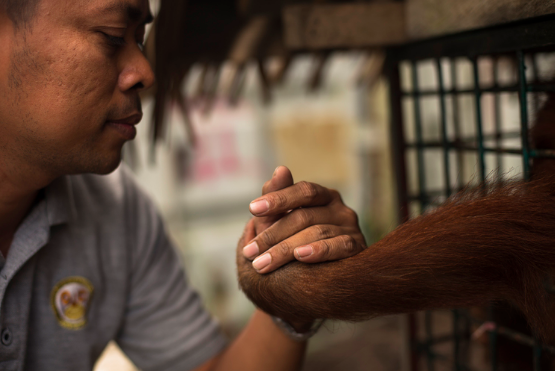
Panut Hadisiswoyo makes a promise to get “Cece” the Sumatran orangutan to safety. Photo by Danielle Da Silva
I connected with a band in Sumatra called New Soerkam, a group of young Indigenous people who listen to Elders’ stories and share them through music. I’ve learned that the Batak people used to have ceremonial “wedding” songs they would sing to the orangutans during mating season to encourage the joyous occasion. To me this is not just a cute practice—it goes much deeper than that, demonstrating a close kinship and awareness of the balance that orangutans bring to human lives. Similarly, Batak people had song they would sing to the palm sugar tree, asking for both permission and forgiveness before taking of her fruit and fronds, which would be harvested and made into palm sugar or brooms, respectively. When applying this type of relationship to conservation, you see a very different relationship form with the land and the beings on the land.

Sumatran orangutans. Photo by Danielle Da Silva
This is very different from the form of conservation commonly practiced, which prioritizes land and wildlife protection, without considering indigenous knowledge and sovereignty, and often seeks to steer Indigenous people and communities off the land, away from land-based practices such as hunting and collecting firewood, and into cities or situations that completely alters the thousands of years of connection with the land. Missionaries and colonialism have done more damage than we currently acknowledge, and to replicate these colonial practices and behaviors in conservation is also often doing more damage. There is a reverence, connection and respect for the land that Indigenous people carry that I don’t see with all conservationist or large conservation organizations. It’s a reciprocal relationship where humans play a role in taking care of the land. I think conservation is necessary, but it needs to have Indigenous people and local people at the helm of the decision-making and ideation.
Together with Panut and OIC, PWB and I have established a project called the Sumatran Wildlife Sanctuary. So now every time I go to Sumatra, I run my own campaigns to help raise awareness and ultimately funds to help keep building the sanctuary. To date we’ve conserved 10 hectares of forest land that is adjacent to the Gunung Leuser National Park. The OIC has also been buying up palm oil plantations to convert back into forests. OIC developed a technique for reforestation that takes around three to five years. They are actually seeing wildlife coming back and the ecosystem is regenerating. It gives me so much hope. I mean it’s really their work not mine. That’s what my work is— finding people, that are doing the work and then to uplift them and their stories because there’s so many local people already doing great work who often get sidelined from the storyline. Someone with more power and more privilege goes in and does their own project even if it might not be as sustainable. A lot of what OIC is doing is unprecedented, the way that they’re able to regrow forests. Something that was thought impossible by many conservationists. You know, when I was in conservation biology school, doing my undergrad, they told us that re-growing a healthy, functioning forest in such a short span of time was impossible.
I think it’s important that we look at the local people who have been dedicating their lives to this work, even in a society that is so difficult to work in. These are the people who are going to continue doing the work, remain in the area, and not just move on to some other project.
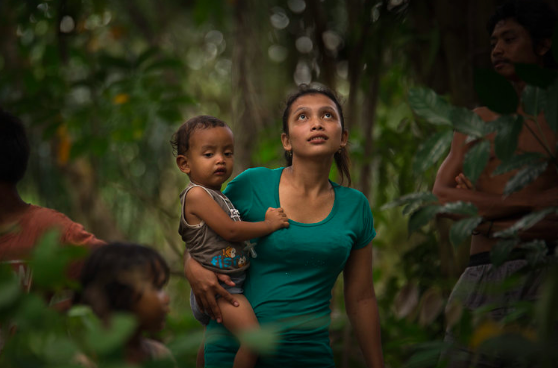
OIC educates villages and future generations about how forests impact livelihoods and the environment. Photo by Danielle Da Silva.
Q: When you were in Sumatra documenting the work of the Orangutan Information Centre (OIC) what kinds of human-orangutan conflicts did you see? What was it like going on an orangutan rescue mission with the OIC?
I happened to be in Sumatra on a Photographer’s Without Borders assignment to document orangutan rescue with the Orangutan Information Centre. This organization is working to save rainforest and orangutans from extinction in Sumatra. OIC has a unit to rescue orangutans that come into conflict with humans or that are being illegally held or trafficked. The OIC work with local organizations that help rehabilitate rescued orangutans. They protect and reclaim conserved rainforest that is illegally cleared by palm oil companies. The OIC also reforests old palm plantation sites and reclaimed lands, and they educate and involve local people and children in these efforts.
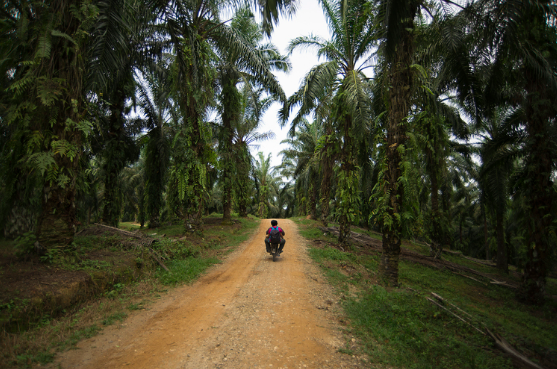
Through the palm plantations. Photo by Danielle Da Silva.
I was working with a local Batak man named Darma who is an unsung hero of the world. He lives in the village and he has created a program to help farmers protect their crops from orangutans and other animals. What happens is wild animals such as tigers will come and take their livestock, their cattle, orangutans will pick their fruit. So that’s why there’s this human-orangutan conflict problem. Darma has empowered the local farmers to plant saplings and seedlings for the orangutans because orangutans are going to come in and steal all your fruit. But Darma realized if you plant some intentionally for the orangutans they can take some and then you have some for yourself, this helps farmers mitigate these problems.
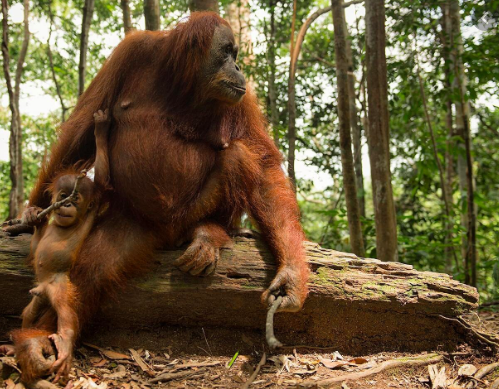
Photo by Danielle Da Silva.
Darma is also a forest ranger and he had worked with some of the rehabilitated orangutans who have been released into the forest, some of the orangutans recognized him still. When I met this orangutan named Mina she had scars all over her body from being hit with a machete so many times. She was taken from her mom’s dead arms. They have to kill a baby orangutan’s mother because their mothers are so protective of them and they will fight tooth and nail to protect their young. She endured so much trauma. She ended up in a cage because of the wildlife trafficking trade. Someone wanted her as a pet and someone got paid to kill her mother and pry Mina out of her arms. She was rescued from the cage and then learned from humans. She learned so much from humans and is incredibly smart. Mina learned how to manipulate and to use bribery as a tool, she learned how to protect herself and how to protect her babies. When I met her, it was beautiful because Darma had been her keeper when she was in the rehabilitation center. So they had a good relationship and she would let us watch her play with her baby. Over the years I’ve gone back to visit her. For me it was a very profound experience because I was feeling so deflated by life and interacting with Mina and all that she had been through really gave me a lot of life. It gave me this feeling of kinship that I didn’t have with anyone else. I felt really alone and alienated by the experiences I was having and there was just no support available. I’ve always found nature to be very therapeutic.
Q: I read that you spend most of your time in rainforests and jungles by choice, what is it about these ecosystems that draws you in?
Even right now as we speak, I’m sitting on my property, it’s a 30-acre forest in Northern Ontario. So forests in general are my happy place. Reason being is because I just feel like it’s where I can hear and listen and learn the most. Forests have a really strong heartbeat and pulse. This has always been a place where I feel like there’s just so much life and interconnection that you can witness and experience. All your senses are just absorbing what is around you. In these spaces I feel super connected to the planet and my purpose and I feel like I can be much more grounded in those environments. I see the contrast of growing up in a city surrounded by concrete and now I live in a house in the woods where, it’s not much, but it’s exactly what I need. I can maintain it. I live in this beautiful forest. I find myself using so much less waste and growing my own vegetables. It feels really aligned with how I want to be in this world.
Q: In the past you have said, “what troubles me most in the world is apathy, and that comes from being bombarded with a lot of negativity and images that leave people feeling helpless.” How do you seek to empower viewers with your photos?
When I am thinking about stories to document they have to be related to a cause or related to a purpose. That’s kind of the filter I send everything through. Recently, I started an online exhibit with my two mentees called “sweetgrass sugarcane saffron.” We are Anishinaabe, black and Indian, and we each embodied one of the three medicines according to our ancestral histories. For me, that was saffron, a healing spice that can balance doshas in ancient Indian Ayurveda, and is the color of sadhus’ robes. They are all double exposures of women in India and tigers; Did you know that it was women in India that were the first to hug trees to save them? This happened in the Himalayas and was called the Chipko movement. I see Indian women as incredibly strong, like the goddesses revered in Hindu beliefs. And they are the water carriers, the keepers of nurturing knowledge. Some of the tigers are wild Royal Bengal tigers in India, some of them are Royal Bengals in zoos. I’m trying to transpose women into their rightful place, as protectors and caretakers. I’m trying to heal the pain of those in cages by placing them in healing hands, and bringing in the energy of what it feels like to be wild. Everything is interconnected—from protecting wildlife and their habitats, to protecting women and children, and seeking justice for all. And I set the images to poetry.
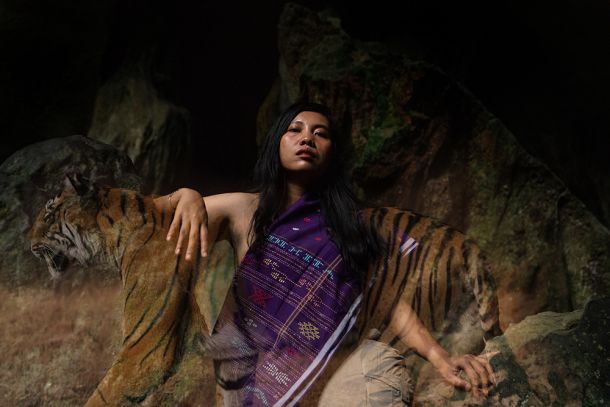
From the exhibit “sweetgrass sugarcane saffron.” Photo by Danielle Da Silva
Everything I do has a purpose, and that purpose may or not be to empower. This particular set of work was not so much meant to empower the viewer, but to help others see and feel the interconnectedness that I see and feel.
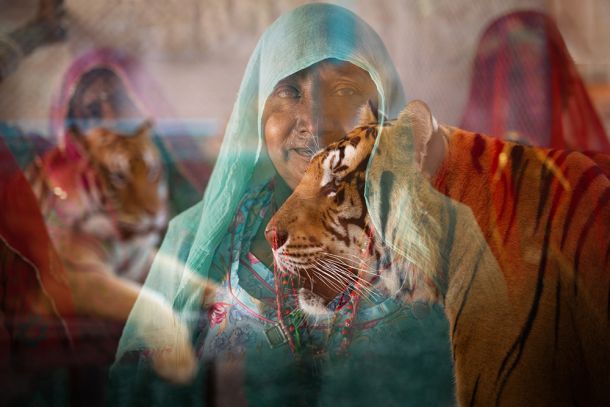
“I’m trying to transpose women into their rightful place, as protectors and caretakers.” Photo by Danielle Da Silva.
I think it is important to show people the little things that they can control in their own lives. This is super key. There is a great quote by Howard Thurman: “Don’t ask what the world needs. Ask what makes you come alive, and go do it.” We need more people that have come alive and are doing the things that make them feel alive. At the end of the rainbow, it’s not just the grassroots organizations that are saving the environment, but the actual people behind them. If this person who grew up with nothing in India can do this, imagine what you can do? If we can empower people to action through these examples of everyday heroes, it shows that each and every one of us can do something even in our own backyard. So there’s all these subtle levels of inspiration that I hope to get across.
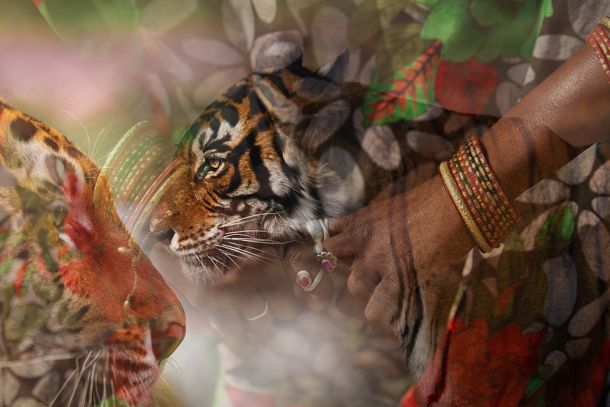
“I’m trying to heal the pain of those in cages by placing them in healing hands, and bringing in the energy of what it feels like to be wild.” Photo by Danielle Da Silva.
Q: It seems like empowering local communities is also an important ethos of the organization you founded, Photographers Without Borders. How does storytelling from a grassroots level help achieve tangible impact?
Another reason why I love Sumatra and working with Orangutan Information Center is the amount of work they are able to do, and how they’ve done it in their own way, which is completely different from how other conservation organizations go about their work. They hire only Indonesians, and it was founded by an Indonesian. They also hire women to do field work. They also help local people. They don’t villainize the palm oil workers. Some are friends with them and they try to get them to come and work with their organization instead of working at the palm oil plantations. They are trying to create alternative livelihoods and those are the kinds of solutions you see when you work with the grassroots organizations. OIC is doing this on a very large scale. They’re just not broadcasting it loud enough to the rest of the world. I wish that they could get more attention on their work because it’s the best kind of example that I think we need to follow. Millions of dollars have gone into conservation efforts that failed because organizations couldn’t get the locals onsite. Its because they did not go in with an approach of working with local people. It has always been this top down, I am better than thou, you know, elitist, righteous perspective. I want to believe it comes from a good place, but I think there are many well-intentioned people and organizations that make very poor decisions that end up with disastrous consequences. I’m happy to see many organizations are moving in the direction of supporting more community-based projects.
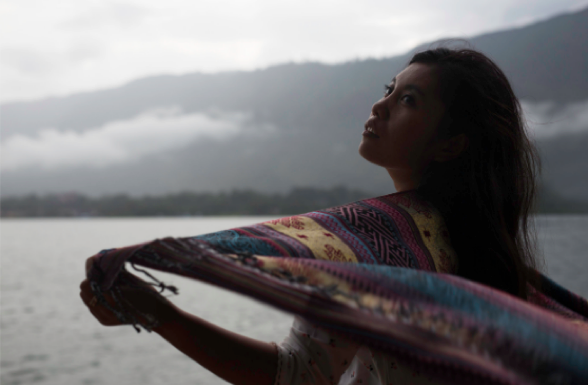
This is Nayla, a young Batak woman, who journeys without and within to reclaim her Batak culture. Photo by Danielle Da Silva.
At PWB we’re consulting with all of our international community partners (NGOs, charities and social enterprises slated to receive volunteer storytellers on assignments) to try and see how we can support them with the stories that we have created. We want to empower them to use storytelling to take up a bigger piece of the pie on the internet. We see Photographers Without Borders as the vehicle for amplifying voices. The way to combat this apathy is by showing people all the positive projects that are happening. Such as the 2,300 renewable indigenous projects and that’s just indigenous communities alone across Canada. Or the work that Indian women are doing to empower the girls of tomorrow. These are just a couple of examples in the sea of the hundreds of community partners we work with.
Q: PWB’s Code of Ethics prioritizes diversity and inclusion, accessibility, acknowledging repression as well as colonization, and creating impact. How did you develop these core values? Were they inspired by your own experiences as a storyteller?
We have to be leaders. When we come together as a team, we envision our organization as a thought-leader in this space. So we need to act accordingly. I think me being a person of color who has always had friends who are bipoc (black/indigenous/people of color) from all over the world has played a huge important role. Being around activists and people of color has educated me in ways that you can’t get from school. It’s been a lot of understanding my own oppression and understanding how colonization has impacted me as a person. It’s just been a lifetime of learning. People who have very elite, privileged backgrounds have no connection to what is happening on the ground. Myself included, until I got to know certain communities. That is why I’ve gone from traveling to so many different places to just sticking to a couple and getting to know them really well. The reason why I’ve stuck to specific places is all based on relationships. Instead of following stories, I follow relationships and I want to do the most for those communities, rather than spreading myself thin.
Q: It seems like preserving the natural world is another core value of your organization. Could you tell me about a few PWB projects that are contributing to environmental conservation?
We have helped conserve 10 hectares of rainforest in Sumatra, supported reforestation efforts by planting hundreds of trees, sent girls to school in India, helped human trafficking survivors in Kenya, and assisted marine protection in Mozambique. There’s an organization in Columbia called Green Hope Colombia that’s working to preserve the Amazon rainforest as well as the local indigenous communities. They also help facilitate the knowledge transfer of traditional farming practices. In a lot of communities in the Amazon, a lot of the fruit trees in the forest weren’t just randomly scattered around. These communities have intentional farming methods, used by the Amazonian people. That is one of the practices for example, forest farming, that they do. One of the big things that we’re doing right now is we’re trying to join the United Nations as an ECOSOC representative, a civil society representative. This would allow us to aggregate all of our NGOs and deal in certain areas around certain sustainable development goals. We have chosen three focuses, ours are: women, forests and indigenous peoples. We are trying to focus on those three areas because if you talk about the protection of the natural world, I think all three of those things are really important elements to me as an individual. To PWB as an organization itself, those three categories just happened to be where most of our projects center around.
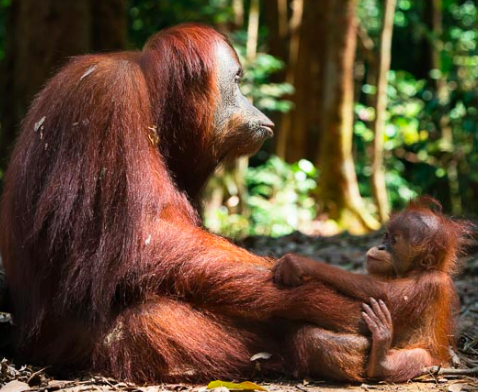
Photo by Danielle Da Silva.
